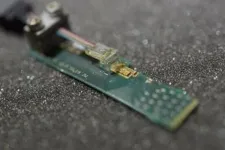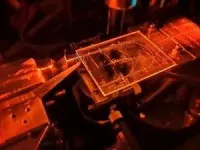(Press-News.org) WASHINGTON — Researchers have developed a quantum key distribution (QKD) system based on integrated photonics that can transmit secure keys at unprecedented speeds. The proof-of-principle experiments represent an important step toward real-world application of this highly secure communication method.
QKD is a well-established method of providing secret keys for secure communication between distant parties. By using the quantum properties of light to generate secure random keys for encrypting and decrypting data, its security is based on the laws of physics, rather than computational complexity like today’s communication protocols.
“A key goal for QKD technology is the ability to simply integrate it into a real-world communications network,” said research team member Rebecka Sax from the University of Geneva in Switzerland. “An important and necessary step toward this goal is the use of integrated photonics, which allows optical systems to be manufactured using the same semiconductor technology used to make silicon computer chips.”
In the Optica Publishing Group journal Photonics Research, researchers led by University of Geneva’s Hugo Zbinden describe their new QKD system, in which all components are integrated onto chips except the laser and detectors. This comes with many advantages such as compactness, low cost and ease of mass production.
“Although QKD can provide security for sensitive applications such as banking, health and defense, it is not yet a widespread technology,” said Sax. “This work justifies the technology maturity and helps address the technicalities around implementing it via optical integrated circuits, which would allow integration in networks and in other applications.”
Building a faster chip-based system
In previous work, the researchers developed a three-state time-bin QKD protocol that was carried out with standard fiber-based components to achieve QKD transmission at record high speeds.
“Our goal in this new work was to implement the same protocol using integrated photonics,” said Sax. “The compactness, robustness and ease of manipulation of an integrated photonic system — with less components to verify when implementing or to troubleshoot in a network — improves the position of QKD as a technology for secure communication.”
QKD systems use a transmitter to send the encoded photons and a receiver to detect them. In the new work, the University of Geneva researchers collaborated with silicon photonics company Sicoya GmbH in Berlin, Germany, and quantum cybersecurity company ID Quantique in Geneva to develop a silicon photonics transmitter that combines a photonic integrated circuit with an external diode laser.
The QKD receiver was made of silica and consisted of a photonic integrated circuit and two external single-photon detectors. Roberto Osellame’s group at the CNR Institute for Photonics and Nanotechnology in Milano, Italy, used femtosecond laser micromachining to fabricate the receiver.
“For the transmitter, using an external laser with a photonic and electronic integrated circuit made it possible to accurately produce and encode photons at a record speed of up 2.5 GHz,” said Sax. “For the receiver, a low-loss and polarization independent photonic integrated circuit and a set of external detectors allowed passive and simple detection of the transmitted photons. Connecting these two components with a standard single-mode fiber enabled high-speed production of secret keys.”
Low-loss, high-speed transmission
After thoroughly characterizing the integrated transmitter and receiver, the researchers used it to perform a secret key exchange using different simulated fiber distances and with a 150-km long single-mode fiber and single-photon avalanche photodiodes, which are well-suited for practical implementations. They also performed experiments using single-photon superconducting nanowire detectors, which enabled a quantum bit error rate as low as 0.8%. The receiver not only featured polarization independence, which is complicated to achieve using integrated photonics, but also presented extremely low loss, around 3 dB.
“In terms of secret key rate production and quantum bit error rates, these new experiments produced results that are similar to those of previous experiments performed using fiber-based components,” said Sax. “However, the QKD system is much simpler and more practical than the previous experimental setups, thus displaying the feasibility of using this protocol with integrated circuits.”
The researchers are now working to house the system parts in a simple rack enclosure that would allow QKD to be implemented in a network system.
Paper: R. Sax, A. Boaron, G. Boso, S. Atzeni, A. Crespi, F. Grünenfelder, D. Rusca, A. Al-Saadi, D. Bronzi, S. Kupijai, H. Rhee, R. Osellame, H. Zbinden, “High-speed integrated QKD system,” Photonics Research, 11, 6, 1007-1014 (2023).
DOI: https://opg.optica.org/prj/fulltext.cfm?uri=prj-11-6-1007&id=530973
About Optica Publishing Group (formerly OSA)
Optica Publishing Group is a division of the society, Optica (formerly OSA), Advancing Optics and Photonics Worldwide. It publishes the largest collection of peer-reviewed and most-cited content in optics and photonics, including 18 prestigious journals, the society’s flagship member magazine, and papers and videos from more than 835 conferences. With over 400,000 journal articles, conference papers and videos to search, discover and access, our publications portfolio represents the full range of research in the field from around the globe.
About Photonics Research
Photonics Research disseminates fundamental and applied research progress in optics and photonics. Published by Chinese Laser Press and Optica Publishing Group and led by Editor-in-Chief Lan Yang, Washington University in St. Louis, USA. For more information, visit Photonics Research.
Media Contact
mediarelations@optica.org
END
Chip-based QKD achieves higher transmission speeds
Quantum key distribution system based on integrated photonics lays groundwork for network implementation
2023-05-25
ELSE PRESS RELEASES FROM THIS DATE:
The brain’s protein-destruction machine learns new tricks at synapses, revealing a potential target for treating neurological disorders
2023-05-25
Darwin’s theory of evolution highlighted the importance of adaption and diversity in the natural world. Inside a biological cell, can proteins also perform new functions in new contexts? The answer seems to be yes for the brain’s primary protein-degradation machine, especially when it is placed at synapses, revealing a hitherto unknown mechanism that allows synapses to change in response to different circumstances.
The role of the regulatory (19S) proteasome particle has always been exclusively linked to its functioning in the proteasome complex, where it collaborates with the catalytic (20S) particle to recognize ...
Polar fish are less likely to die early, so they prioritize growth over reproduction
2023-05-25
Polar fish experience lower mortality than tropical fish, allowing them to delay reproduction until later in life when they are larger and can produce more eggs, according to a study by Mariana Álvarez-Noriega at Monash University in Australia and colleagues, publishing May 25th in the open access journal PLOS Biology. This may have implications for the effects of climate change on the sustainability of fish populations.
Organisms face a trade-off around when is the best time to reproduce. Fish continue to grow throughout life and larger fish tend to produce disproportionately more eggs than smaller fish, so it ...
Arctic ground squirrels changing hibernation patterns
2023-05-25
Arctic ground squirrels are unique among mammals. Their ability to keep from freezing even when body temperatures dip below that mark on the thermometer enables them to survive extreme winter climates. New research published in Science analyzes more than 25 years of climate and biological data. The findings include shorter hibernation periods and differences between male and female hibernation periods. Spoiler alert - the girls “rise and shine” a little earlier in response to warming, which could have both positive and negative ripple effects throughout the food web in these ecosystems.
Senior ...
As Arctic warms, female arctic ground squirrels end hibernation before males – a mismatch with consequences
2023-05-25
As Alaskan permafrost warms, hibernating arctic ground squirrels generate less heat, causing females to emerge from hibernation up to 10 days before their male counterparts – a mismatch that could have large, cascading ecological impacts. The findings of the related study reveal both direct and indirect impacts of a warming world. Winter temperatures play a fundamental role in fitness and population dynamics for many species that live in higher latitudes. However, in the Arctic, where warming is occurring more rapidly than most other places on ...
Stressed soil microbial communities bolster tree resilience to changing climates
2023-05-25
Soil microbiota transplanted from more stressful environmental conditions – drought or excessive heat or cold, for example – can enhance tree tolerance to changing climates, researchers report. The findings suggest that management of soil microbiota, especially during forest restorations, could be a valuable strategy for increasing forest resilience to climate change. Climate change is forcing many species outside of their evolved range of environmental tolerances, forcing them to acclimate, adapt, or migrate to avoid extinction. For long-lived ...
Combining data types refines grasp of French Canadian ancestry in Quebec, revealing how local topographies influenced relatedness, and more
2023-05-25
Combining a comprehensive dataset – including marriage documents – compiled from more than 4 million Catholic parish records with genotype data for more than 22,000 French and French Canadian individuals, researchers have conducted a novel analysis of French Canadian ancestry in Quebec, Canada, since the 17th Century. While most other population genetic models provide only coarse representations of a region’s real-world ancestry, this new approach reveals detailed insights into historic European colonization, migration, and settlement patterns, reflecting intricate French Canadian population structures within geographic constraints. ...
International pandemic governance need not prioritize compliance and sanctions
2023-05-25
In a Policy Forum, Mark Eccleston-Turner and colleagues argue that upcoming negotiations surrounding the World Health Organization (WHO) international pandemic treaty need not be overly focused on formal compliance mechanisms and sanctions. Instead, Eccleston-Turner et al. suggest that any efforts to ensure compliance should be part of broader efforts to ensure effective and equitable implementation across all member states. Member states of the World Health Organization (WHO) are preparing for ambitious ...
River erosion can shape fish evolution, study suggests
2023-05-25
If we could rewind the tape of species evolution around the world and play it forward over hundreds of millions of years to the present day, we would see biodiversity clustering around regions of tectonic turmoil. Tectonically active regions such as the Himalayan and Andean mountains are especially rich in flora and fauna due to their shifting landscapes, which act to divide and diversify species over time.
But biodiversity can also flourish in some geologically quieter regions, where tectonics hasn’t shaken up the land for millennia. The Appalachian Mountains are a prime example: The range ...
River erosion drives fish biodiversity in the Appalachians
2023-05-25
New Haven, Conn. — The gradual erosion of layers of rock by rivers flowing through the Appalachian Mountains generates biodiversity of freshwater fish species, suggests a new Yale-led study that offers insight into the causes of species richness in the ancient mountain range.
Researchers have previously associated high biodiversity in mountain ranges, including the Andes and Himalaya, with tectonic uplift — the shifting of plates in the Earth’s crust that forms mountains, plateaus, and other geologic structures — triggering environmental changes that create conditions ripe for species diversification. ...
Researchers at the Faculty of Physics of the University of Warsaw have created a new, highly efficient converter of quantum information carriers
2023-05-25
Researchers at the University of Warsaw's Faculty of Physics have developed a new, highly efficient technique that makes quantum information transmission dozens of times faster. The results of the research, published in the prestigious journal Nature Photonics, may in the near future contribute to the development of superfast quantum Internet connections.
Light is a key carrier of information. It enables high-speed data transmission around the world via fiber-optic telecommunication networks. This information-carrying capability can be extended to transmitting quantum information by encoding ...
LAST 30 PRESS RELEASES:
First Editorial of 2026: Resisting AI slop
Joint ground- and space-based observations reveal Saturn-mass rogue planet
Inheritable genetic variant offers protection against blood cancer risk and progression
Pigs settled Pacific islands alongside early human voyagers
A Coral reef’s daily pulse reshapes microbes in surrounding waters
EAST Tokamak experiments exceed plasma density limit, offering new approach to fusion ignition
Groundbreaking discovery reveals Africa’s oldest cremation pyre and complex ritual practices
First breathing ‘lung-on-chip’ developed using genetically identical cells
How people moved pigs across the Pacific
Interaction of climate change and human activity and its impact on plant diversity in Qinghai-Tibet plateau
From addressing uncertainty to national strategy: an interpretation of Professor Lim Siong Guan’s views
Clinical trials on AI language model use in digestive healthcare
Scientists improve robotic visual–inertial trajectory localization accuracy using cross-modal interaction and selection techniques
Correlation between cancer cachexia and immune-related adverse events in HCC
Human adipose tissue: a new source for functional organoids
Metro lines double as freight highways during off-peak hours, Beijing study shows
Biomedical functions and applications of nanomaterials in tumor diagnosis and treatment: perspectives from ophthalmic oncology
3D imaging unveils how passivation improves perovskite solar cell performance
Enriching framework Al sites in 8-membered rings of Cu-SSZ-39 zeolite to enhance low-temperature ammonia selective catalytic reduction performance
AI-powered RNA drug development: a new frontier in therapeutics
Decoupling the HOR enhancement on PtRu: Dynamically matching interfacial water to reaction coordinates
Sulfur isn’t poisonous when it synergistically acts with phosphine in olefins hydroformylation
URI researchers uncover molecular mechanisms behind speciation in corals
Chitin based carbon aerogel offers a cleaner way to store thermal energy
Tracing hidden sources of nitrate pollution in rapidly changing rural urban landscapes
Viruses on plastic pollution may quietly accelerate the spread of antibiotic resistance
Three UH Rainbow Babies & Children’s faculty elected to prestigious American Pediatric Society
Tunnel resilience models unveiled to aid post-earthquake recovery
Satellite communication systems: the future of 5G/6G connectivity
Space computing power networks: a new frontier for satellite technologies
[Press-News.org] Chip-based QKD achieves higher transmission speedsQuantum key distribution system based on integrated photonics lays groundwork for network implementation






